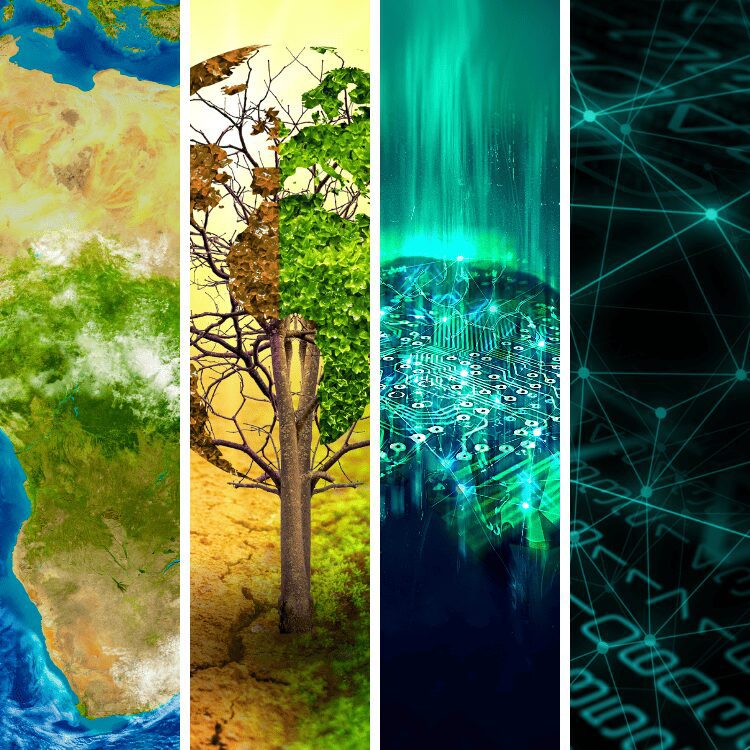When it comes to climate change, it’s important for all of us to think in new ways. For example, can we use artificial worlds to improve access to energy data? Are there ways to track climate change with satellites and AI?
Guests:
- Marc Jeuland, faculty member at the Sanford School of Public Policy at Duke University
- Kyle Bradbury, Managing Director of the Energy Data Analytics Lab at the Nicholas Institute for Energy, Environment, and Sustainability
This is the first of.a series of conversations about climate change.
Conversation Highlights
Responses have been edited for clarity.
Marc Jeuland on a potential value of satellite imagery in energy infrastructure data
Some of my work in the past has looked at hydropower dams in the Blue Nile Basin and Ethiopia, [where] you have to push the water through hydroelectric turbines to generate electricity. Downstream, farmers care a lot about what the water releases will be from that dam. It’s quite shocking, but there is no publicly available data on flows in much of the Nile that planners can use or that micro-level actors like farmers, city residents can use to understand when there’s going to be a shortfall of water. But with satellite information, in theory, you can start to see, ‘Is the water flow actually low or is it something related to the operations of that infrastructure?’ And that’s really important for having trust in the system because if you’re a downstream farmer and you don’t get water, there are two possibilities. One is that it’s very dry and there is no water. And the other possibility is that the water’s not being released properly to meet your needs. And those two things are quite different, but they can get conflated in people’s minds, leading to all kinds of negative consequences.
Kyle Bradbury on scaling satellite imagery data analysis using machine learning algorithms
There’s value from satellite data when we’re able to really scale this up globally. But in reality, the techniques that underlie all of these analyses are different types of machine learning techniques and applying them globally is pretty hard. We typically need some sort of what we call training data. (Basically, if you wanted to teach an algorithm what a solar panel looks like, you have to show it a lot of examples of solar panels.)
So when we typically do that, we grab some data from a couple of cities. We label them by drawing some boxes around the solar panels and [letting the algorithm learn] what a solar panel looks like. But in reality, we’ve only fed in data from a couple of cities. [But] when you think about the ambitions for the applications of these type of technologies, we want them to be global. We want them to be able to be applied broadly, but a typical rooftop in Boston, Massachusetts may look very different from a typical rooftop from somewhere in Southeast Asia or somewhere in Africa.
[We are working on two options to overcome that.] One is, give [the system] examples from every place on Earth. Well, that’s probably a little bit infeasible. So the other option is to create an artificial location and [we can take artificial images of these places, like a 3d model of a city with the images from overhead, and we] use these synthetic versions of the location as a way to teach these automated techniques to learn to identify the types of infrastructure or natural resources that we’re interested in. So that’s what that project is focused on. It’s trying to use new approaches to create these synthetic, artificial versions of different places in order to allow us to really analyze data globally and not have it be biased towards a handful of cities where we happen to have some data from.Marc Jeuland’s outlook on humanity’s ability to tackle mounting challenges of climate change
I definitely think that we have a lot of possibility to address [the challenges of climate change] and many relevant technologies exist (although we need more) but where I’m more of a pessimist is whether we have the will to actually implement the policies that are needed to support that technological deployment. And that’s where, if I start to think about the political process and how climate impacts are going to play out, I start becoming more pessimist because I think that a lot of the misalignment that we have in our politics is because of lack of good information that people have. And also, people not really understanding the risks properly to support the types of political leaders that we need to enact changes.
Kyle Bradbury’s outlook on humanity’s ability to tackle climate change
When we’re looking at energy systems and climate, we see a few major trends right now. One is the incredible increase in economic viability of wind and solar. The rapid increase in the maturity of technologies like energy storage. And there’s a lot of flexibility that adds to the grid. And then things like increased safety in modern reactor designs and things that are maybe a little less obvious, but I think are super exciting, like increasing efficiency of lighting and our everyday appliances, which is bringing down demand even in a time when we’re seeing increased use of a lot of different appliances. So all of those are coming together, this distributed generation, asynchronous generation and greater efficiency to really change the way that we think about our energy systems infrastructure and in a way that provides a lot more levers for system operators and policy makers and corporate actors to explore, just to see how we can evolve our conception of the energy system, which in the 1990s and 2000s was almost thought to be old news.
- Subscribe to Policy 360 at Apple Podcasts, or wherever you get your podcasts
- Read conversation transcript


